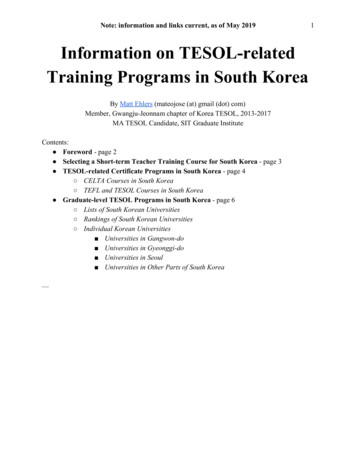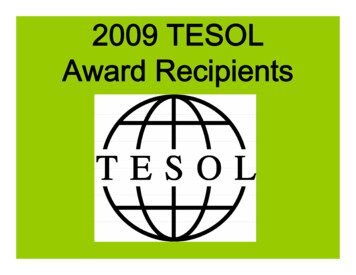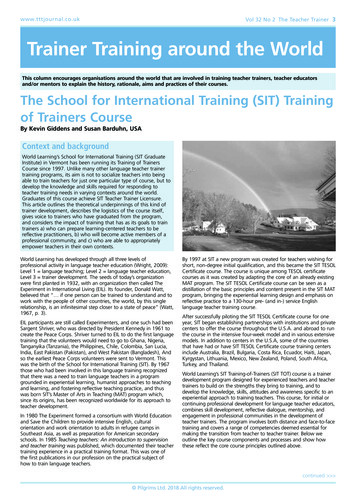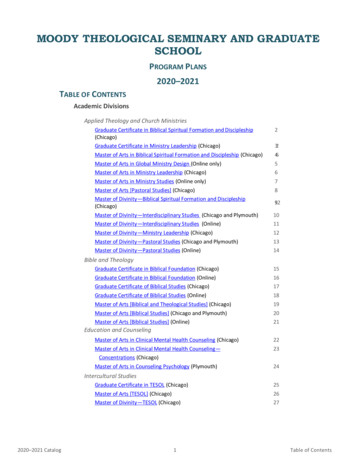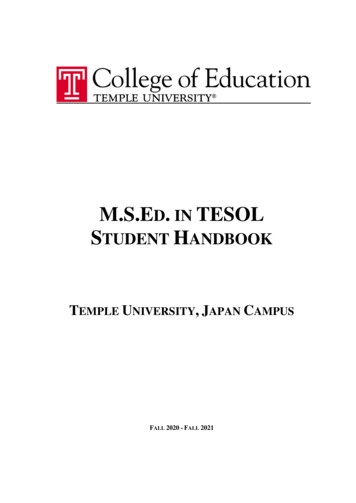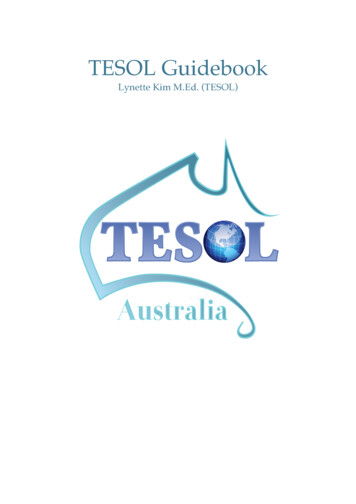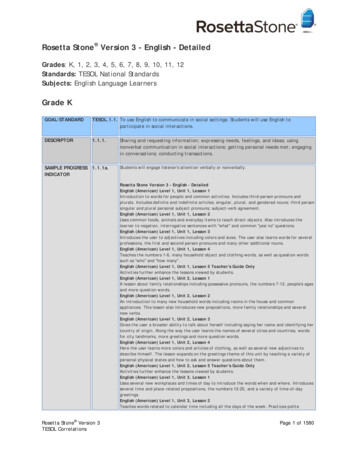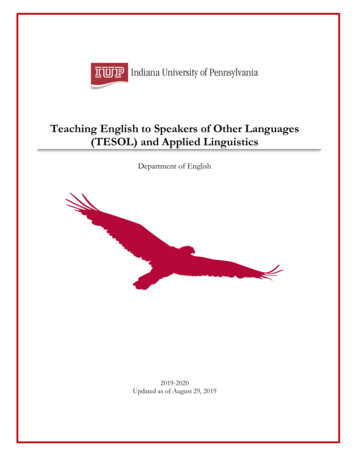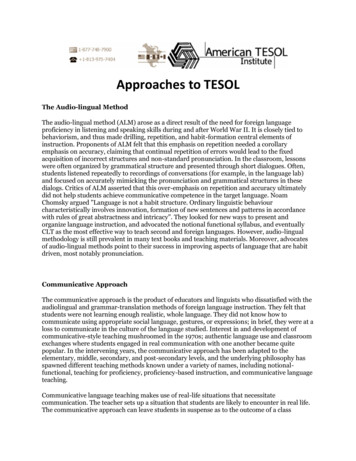
Transcription
Approaches to TESOLThe Audio-lingual MethodThe audio-lingual method (ALM) arose as a direct result of the need for foreign languageproficiency in listening and speaking skills during and after World War II. It is closely tied tobehaviorism, and thus made drilling, repetition, and habit-formation central elements ofinstruction. Proponents of ALM felt that this emphasis on repetition needed a corollaryemphasis on accuracy, claiming that continual repetition of errors would lead to the fixedacquisition of incorrect structures and non-standard pronunciation. In the classroom, lessonswere often organized by grammatical structure and presented through short dialogues. Often,students listened repeatedly to recordings of conversations (for example, in the language lab)and focused on accurately mimicking the pronunciation and grammatical structures in thesedialogs. Critics of ALM asserted that this over-emphasis on repetition and accuracy ultimatelydid not help students achieve communicative competence in the target language. NoamChomsky argued "Language is not a habit structure. Ordinary linguistic behaviourcharacteristically involves innovation, formation of new sentences and patterns in accordancewith rules of great abstractness and intricacy". They looked for new ways to present andorganize language instruction, and advocated the notional functional syllabus, and eventuallyCLT as the most effective way to teach second and foreign languages. However, audio-lingualmethodology is still prevalent in many text books and teaching materials. Moreover, advocatesof audio-lingual methods point to their success in improving aspects of language that are habitdriven, most notably pronunciation.Communicative ApproachThe communicative approach is the product of educators and linguists who dissatisfied with theaudiolingual and grammar-translation methods of foreign language instruction. They felt thatstudents were not learning enough realistic, whole language. They did not know how tocommunicate using appropriate social language, gestures, or expressions; in brief, they were at aloss to communicate in the culture of the language studied. Interest in and development ofcommunicative-style teaching mushroomed in the 1970s; authentic language use and classroomexchanges where students engaged in real communication with one another became quitepopular. In the intervening years, the communicative approach has been adapted to theelementary, middle, secondary, and post-secondary levels, and the underlying philosophy hasspawned different teaching methods known under a variety of names, including notionalfunctional, teaching for proficiency, proficiency-based instruction, and communicative languageteaching.Communicative language teaching makes use of real-life situations that necessitatecommunication. The teacher sets up a situation that students are likely to encounter in real life.The communicative approach can leave students in suspense as to the outcome of a class
exercise, which will vary according to their reactions and responses. The real-life simulationschange from day to day. Students' motivation to learn comes from their desire to communicatein meaningful ways about meaningful topics.Total Physical ResponseTotal physical response (TPR) is a method developed by Dr. James J. Asher, a professoremeritus of psychology at San José State University, to aid learning second languages. Themethod relies on the assumption that when learning a second or additional language, languageis internalized through a process of codebreaking similar to first language development and thatthe process allows for a long period of listening and developing comprehension prior toproduction. Students respond to commands that require physical movement. TPR is primarilyintended for ESL/EAL teachers, although the method is used in teaching other languages aswell. The method became popular in the 1970s and attracted the attention or allegiance of someteachers, but it has not received generalized support from mainstream educators. According toAsher, TPR is based on the premise that the human brain has a biological program for acquiringany natural language on earth - including the sign language of the deaf. The process is visiblewhen we observe how infants internalize their first language. It looks to the way that childrenlearn their native language. Communication between parents and their children combines bothverbal and physical aspects. The child responds physically to the speech of their parent. Theresponses of the child are in turn positively reinforced by the speech of the parent. For manymonths the child absorbs the language without being able to speak. It is during this period thatthe internalization and codebreaking occurs. After this stage the child is able to reproduce thelanguage spontaneously. With TPR the language teacher tries to mimic this process in class. Themethod also promises double efficiency in terms of rate of learning, according to several studiesin the literature and referenced in the above book.In the classroom the teacher and students take on roles similar to that of the parent and childrespectively. Students must respond physically to the words of the teacher. The activity may be asimple game such as Simon Says or may involve more complex grammar and more detailedscenarios. TPR can be used to practice and teach various things. It is well suited to teachingclassroom language and other vocabulary connected with actions. It can be used to teachimperatives and various tenses and aspects. It is also useful for story-telling. Because of itsparticipatory approach, TPR may also be a useful alternative teaching strategy for students withdyslexia or related learning disabilities, who typically experience difficulty learning foreignlanguages with traditional classroom instruction. According to its proponents, it has a numberof advantages: Students will enjoy getting up out of their chairs and moving around. Simple TPRactivities do not require a great deal of preparation on the part of the teacher. TPR is aptitudefree, working well with a mixed ability class, and with students having various disabilities. It isgood for kinesthetic learners who need to be active in the class. Class size need not be a problem,and it works effectively for children and adults. However, it is recognized that TPR is mostuseful for beginners, though it can be used at higher levels where preparation becomes an issuefor the teacher. It does not give students the opportunity to express their own thoughts in acreative way. Further, it is easy to overuse TPR-- "Any novelty, if carried on too long, will triggeradaptation." It can be a challenge for shy students. Additionally, the nature of TPR places anunnaturally heavy emphasis on the use of the imperative mood, that is to say commands such as"sit down" and "stand up". These features are of limited utility to the learner, and can lead to alearner appearing rude when attempting to use his new language.
Whole Language ApproachWhole language describes a literacy philosophy which emphasizes that children should focus onmeaning and strategy instruction. It is often contrasted with phonics-based methods of teachingreading and writing which emphasize instruction for decoding and spelling. However, fromwhole language practitioners' perspective this view is erroneous and sets up a false dichotomy.Whole language practitioners teach to develop knowledge of language including thegraphophonic, syntactic, semantic and pragmatic aspects of language. Within a whole languageperspective, language is treated as a complete meaning-making system, the parts of whichfunction in relational ways. It has drawn criticism by those who advocate "back to basics"pedagogy or reading instruction because this whole language is based on a limited body ofscientific research. Whole language is an educational philosophy that is complex to describe,particularly because it is informed by multiple research fields including but not limited toeducation, linguistics, psychology, sociology, and anthropology. Several strands run throughmost descriptions of whole language: focus on making meaning in reading and expressing meaning in writing;Constructivist approaches to knowledge creation, emphasizing students' interpretationsof text and free expression of ideas in writing (often through daily journal entries).emphasis on high-quality and culturally-diverse literature;integrating literacy into other areas of the curriculum, especially math, science, andsocial studies;frequent readingo with students in small "guided reading" groupso to students with "read a loud"o by students independently;reading and writing for real purposes;focus on motivational aspects of literacy, emphasizing the love of books and engagingreading materialsMeaning-centered whole to part to whole instruction where phonics are taughtcontextually in "embedded" phonics (different from synthetic or analytic phonics); andemphasis on using and understanding the meaning making role of phonics, grammar,spelling, capitalization and punctuation in diverse social contexts.The Natural ApproachThe Natural Approach was developed by Tracy Terrell and Stephen Krashen, starting in 1977. Itcame to have a wide influence in language teaching in the United States and around the world.The Communicative view of language is the view behind the Natural Approach. Particularemphasis is laid on language as a set of messages that can be understood. The Natural Approachis based on the following tenets: Language acquisition (an unconscious process developed through using languagemeaningfully) is different from language learning (consciously learning or discovering
rules about a language) and language acquisition is the only way competence in a secondlanguage occurs. (The acquisition/learning hypothesis)Conscious learning operates only as a monitor or editor that checks or repairs the outputof what has been acquired. (The monitor hypothesis)Grammatical structures are acquired in a predictable order and it does little good to tryto learn them in another order.(The natural order hypothesis).People acquire language best from messages that are just slightly beyond their currentcompetence. (The input hypothesis)The learner's emotional state can act as a filter that impedes or blocks input necessary toacquisition. (The affective filter hypothesis)The objectives of the Natural Approach are to help beginner become intermediates and todepend on learner needs. And its syllabus is a communicative syllabus. The Natural Approachadopts techniques and activities from different sources but uses them to providecomprehensible input.Art / Musical ApproachIt is said that there is a strong proof of using music in the TESOL classroom. Music andlanguage are tied together in brain processing by pitch, rhythm and by symmetrical phrasing.Music plays a very important role in learning a language. It can help familiarize the studentswith the expressions easily and gives a fun way to learn it.Direct Based Approach / CommunicativeThis approach emphasizes on the target language and utilizes no native language in theclassroom. To make the students actually apply all the targets, conversational exercises andspoken situations can be used. This is essential for the students because they get to practise andbe more comfortable on how to use those expressions in real life situations.Grammar Memorization SpeechThis is the complete opposite of the direct based approach. Using this method, students aretaught the grammatical structures. Some of the activities to attain the objectives of this approachare memorization and applying all grammar rules.
Vocabulary ApproachThis approach refers to the introduction of words, and a series of vocabulary drill. Students canbuild their vocabularies by incidental acquisition or through direct study. To strengthenstudents' vocabulary, activities like "listen and repeat", "quick peek technique" and "what'smissing?" can be used.Rassias MethodIt is a method that uses a lot of entertainment while teaching a language like English. Studentsrepeat words several times for practice while keeping their enthusiasm toward the lessons.Boosting the students’ confidence is one of the primary goals of this teaching style. Rassiasmethod uses of big gestures and have the students sit in a circle rather than the traditionalclassroom setup.
Approaches to TESOL The Audio-lingual Method The audio-lingual method (ALM) arose as a direct result of the need for foreign language proficiency in listening and speaking skills during and after World War II. It is closely tied to behaviorism, and thus made drilling, repetition, and habit-formation central elements of instruction.
